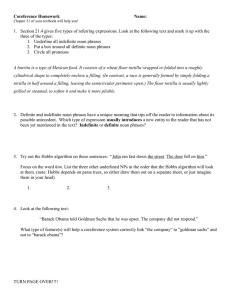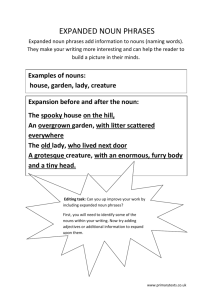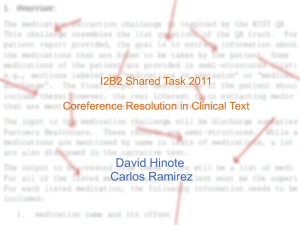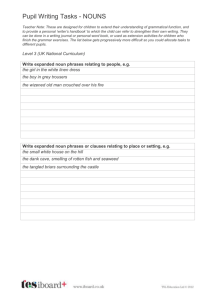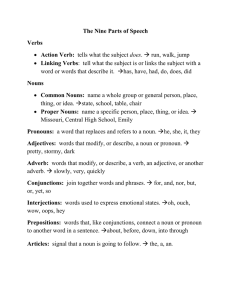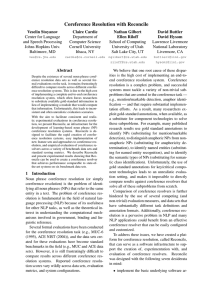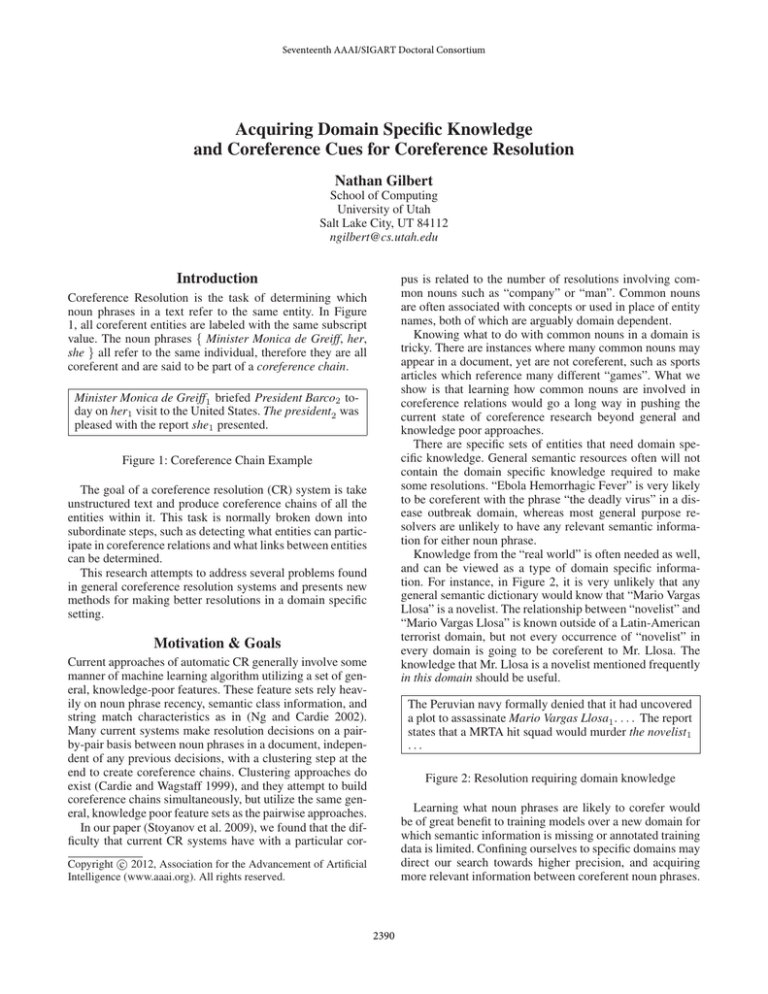
Seventeenth AAAI/SIGART Doctoral Consortium
Acquiring Domain Specific Knowledge
and Coreference Cues for Coreference Resolution
Nathan Gilbert
School of Computing
University of Utah
Salt Lake City, UT 84112
ngilbert@cs.utah.edu
Introduction
pus is related to the number of resolutions involving common nouns such as “company” or “man”. Common nouns
are often associated with concepts or used in place of entity
names, both of which are arguably domain dependent.
Knowing what to do with common nouns in a domain is
tricky. There are instances where many common nouns may
appear in a document, yet are not coreferent, such as sports
articles which reference many different “games”. What we
show is that learning how common nouns are involved in
coreference relations would go a long way in pushing the
current state of coreference research beyond general and
knowledge poor approaches.
There are specific sets of entities that need domain specific knowledge. General semantic resources often will not
contain the domain specific knowledge required to make
some resolutions. “Ebola Hemorrhagic Fever” is very likely
to be coreferent with the phrase “the deadly virus” in a disease outbreak domain, whereas most general purpose resolvers are unlikely to have any relevant semantic information for either noun phrase.
Knowledge from the “real world” is often needed as well,
and can be viewed as a type of domain specific information. For instance, in Figure 2, it is very unlikely that any
general semantic dictionary would know that “Mario Vargas
Llosa” is a novelist. The relationship between “novelist” and
“Mario Vargas Llosa” is known outside of a Latin-American
terrorist domain, but not every occurrence of “novelist” in
every domain is going to be coreferent to Mr. Llosa. The
knowledge that Mr. Llosa is a novelist mentioned frequently
in this domain should be useful.
Coreference Resolution is the task of determining which
noun phrases in a text refer to the same entity. In Figure
1, all coreferent entities are labeled with the same subscript
value. The noun phrases { Minister Monica de Greiff, her,
she } all refer to the same individual, therefore they are all
coreferent and are said to be part of a coreference chain.
Minister Monica de Greiff1 briefed President Barco2 today on her1 visit to the United States. The president2 was
pleased with the report she1 presented.
Figure 1: Coreference Chain Example
The goal of a coreference resolution (CR) system is take
unstructured text and produce coreference chains of all the
entities within it. This task is normally broken down into
subordinate steps, such as detecting what entities can participate in coreference relations and what links between entities
can be determined.
This research attempts to address several problems found
in general coreference resolution systems and presents new
methods for making better resolutions in a domain specific
setting.
Motivation & Goals
Current approaches of automatic CR generally involve some
manner of machine learning algorithm utilizing a set of general, knowledge-poor features. These feature sets rely heavily on noun phrase recency, semantic class information, and
string match characteristics as in (Ng and Cardie 2002).
Many current systems make resolution decisions on a pairby-pair basis between noun phrases in a document, independent of any previous decisions, with a clustering step at the
end to create coreference chains. Clustering approaches do
exist (Cardie and Wagstaff 1999), and they attempt to build
coreference chains simultaneously, but utilize the same general, knowledge poor feature sets as the pairwise approaches.
In our paper (Stoyanov et al. 2009), we found that the difficulty that current CR systems have with a particular cor-
The Peruvian navy formally denied that it had uncovered
a plot to assassinate Mario Vargas Llosa1 . . . . The report
states that a MRTA hit squad would murder the novelist1
...
Figure 2: Resolution requiring domain knowledge
Learning what noun phrases are likely to corefer would
be of great benefit to training models over a new domain for
which semantic information is missing or annotated training
data is limited. Confining ourselves to specific domains may
direct our search towards higher precision, and acquiring
more relevant information between coreferent noun phrases.
c 2012, Association for the Advancement of Artificial
Copyright Intelligence (www.aaai.org). All rights reserved.
2390
Proposed Work
One way of getting a large amount of unannotated resolutions via heuristic approaches such as those from (Bean and
Riloff 2004; Baldwin 1997). These methods are very precise, but suffer from low recall. They also find more general
case resolutions and fewer of the domain-dependent resolutions involving common nouns that we need. New heuristics
based on discourse focus or utilizing external knowledgerich sources such as the web or other domain specific resources may become important in this phase. Increasing the
number of positive (or negative) links gathered from domain
specific unannotated documents is a necessary step of this
research.
The first phase of this work will be to explore the power of
domain specific features in CR systems. I have found that
by using models trained on very general corpora to classify
on more domain specific document sets, the results are surprising. It is the case that the models trained on generic texts
perform better than the models trained on the texts from the
very domain which is being tested. My hypothesis is that the
“same-domain” models are less effective on data requiring
strong domain information because there is no domain specific knowledge present in their models.
The solution to this problem is to introduce features that
incorporate domain specific knowledge. Learning what noun
phrases commonly corefer in a given domain is one way to
do this. It makes sense to learn that “the president” may often refer to “Barack Obama” in a given collection of texts.
Some approaches to this have been tried in (Rahman and Ng
2011), but surprisingly did little to help CR performance.
The authors used general, non-domain specific corpora used
in these experiments. My latest results have shown the true
power of domain specific features is realized when they are
applied to strongly domain related texts.
Another approach is to utilize resources such as the Sundance shallow parser (Riloff and Phillips 2004) to learn what
semantic classes specific nouns (especially common nouns)
refer to in a given domain. Learning that “the case” often
refers to a person in a biomedical domain could help make
resolutions by improving semantic class agreement.
Contextual cues shared between coreferent entities could
be another approach to utilize lexicalization for CR. For
instance, in a sports domain, learning that th phrase: “the
game” is often not coreferent with other instances of “the
game”, but are instead coreferent with noun phrases found
in a particular context such as “last Tuesday’s game”.
Two major problems confront the previous approaches,
and they will compose phase two. One problem is the
“multi-match” scenario. This occurs when there is more than
a single possible lexical or semantic match present as a possible antecedent. An example is a document that contains
both the noun phrases “El Salvador” and “Panama” in which
the noun phrase “the country” could possibly be linked to.
From a domain knowledge standpoint, both antecedents are
possible, but obviously, at least one is incorrect.
Solutions to the “multi-match” problem may require more
attention to be paid to the discourse properties of a document. Utilizing discourse parsers, or creating a focus model
of the entities participating in a document may overcome
this challenge. Another solution may lie in designing a different approach to the classification of resolutions themselves. Instead of looking at each classification in isolation,
consider clustering entities from the start but by utilizing
new domain specific features.
The second problem is how to deal with sparse data.
All the approaches discussed above require some annotated
data. For any domain, the number of entities we’ve witnessed as coreferent in the annotated data set is going to
be small, we need a way of acquire more without annotating
more documents.
Current Progress
I am roughly 75% complete with the first phase of this work
as of February 2012. I have incorporated domain knowledge
that improves performance over previous attempts. I have
yet to look in earnest at utilizing contextual clues which is
the last step of phase one. All of this work has been done by
myself with guidance from my advisor, Ellen Riloff.
I hope to have completed the first phase and have a substantial start on the second phase by July. My plan to complete and defend this work by December 2013.
In summary, we have explored current CR systems and
have identified the lack of domain specific knowledge as
a major problem. I have has successfully acquired domain
specific knowledge from annotated documents that supports
this claim. To continue this research, two subproblems of
this domain specific approach have been identified and paths
for attacking them have been outlined.
References
Baldwin, B. 1997. Cogniac : High precision coreference
with limited knowledge and linguistic resources. Proceedings of a Workshop on Operational Factors in Practical, Robust Anaphora Resolution for Unrestricted Texts.
Bean, D., and Riloff, E. 2004. Unsupervised learning of
contextual role knowledge for coreference resolution. Proceedings of HLT/NAAL 2004.
Cardie, C., and Wagstaff, K. 1999. Noun phrase coreference
as clustering. Proceedings of the Joint SIGDAT Conference
on Empirical Methods in Language.
Ng, V., and Cardie, C. 2002. Improving machine learning
approaches to coreference resolution. Proceedings of the
40th Annual Meeting of the ACL 104–111.
Rahman, A., and Ng, V. 2011. Coreference resolution with
world knowledge. Proceedings of the 49th Annual Meeting
of the Association for Computational Linguistics and Human Language Technologies (ACL-HLT) 814–824.
Riloff, E., and Phillips, W. 2004. An introduction to the
sundance and autoslog systems. Technical report uucs-04015, School of Computing, University of Utah.
Stoyanov, V.; Gilbert, N.; Cardie, C.; and Riloff, E. 2009.
Conundrums in noun phrase coreference resolution: Making
sense of the state-of-the-art. Proceedings of the Joint Conference of the 47th Annual Meeting of the ACL and the 4th
IJCNLP (ACL-IJCNLP 2009).
2391

